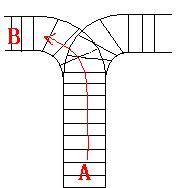hdu1022栈入门
来源:互联网 发布:郑州七中分校知乎 编辑:程序博客网 时间:2024/04/25 21:08
Train Problem I
Time Limit: 2000/1000 MS (Java/Others) Memory Limit: 65536/32768 K (Java/Others)Total Submission(s): 18115 Accepted Submission(s): 6773
Problem Description
As the new term comes, the Ignatius Train Station is very busy nowadays. A lot of student want to get back to school by train(because the trains in the Ignatius Train Station is the fastest all over the world ^v^). But here comes a problem, there is only one railway where all the trains stop. So all the trains come in from one side and get out from the other side. For this problem, if train A gets into the railway first, and then train B gets into the railway before train A leaves, train A can't leave until train B leaves. The pictures below figure out the problem. Now the problem for you is, there are at most 9 trains in the station, all the trains has an ID(numbered from 1 to n), the trains get into the railway in an order O1, your task is to determine whether the trains can get out in an order O2.






Input
The input contains several test cases. Each test case consists of an integer, the number of trains, and two strings, the order of the trains come in:O1, and the order of the trains leave:O2. The input is terminated by the end of file. More details in the Sample Input.
Output
The output contains a string "No." if you can't exchange O2 to O1, or you should output a line contains "Yes.", and then output your way in exchanging the order(you should output "in" for a train getting into the railway, and "out" for a train getting out of the railway). Print a line contains "FINISH" after each test case. More details in the Sample Output.
Sample Input
3 123 3213 123 312
Sample Output
Yes.inininoutoutoutFINISHNo.FINISHFor the first Sample Input, we let train 1 get in, then train 2 and train 3.So now train 3 is at the top of the railway, so train 3 can leave first, then train 2 and train 1.In the second Sample input, we should let train 3 leave first, so we have to let train 1 get in, then train 2 and train 3.Now we can let train 3 leave.But after that we can't let train 1 leave before train 2, because train 2 is at the top of the railway at the moment.So we output "No.".HintHint
设进出两个顺序分别为order1和order2,如果此时栈为空或者当前的栈顶元素不等于order2[i],就让order1[j]入栈,同时将"in"记录入q队列中。else如果此时栈顶元素等于order2[i],就将此栈顶元素弹出(sk.pop()),并将"out"记录入q队列。不断进行上面上面两个判断,直到两个数组遍历完,或者在中途中达不到目标顺序,使程序停止。
#include<iostream>#include<cstdio>#include<cstring>#include<string>#include<cstdlib>#include<cmath>#include<stack>#include<queue>#include<vector>#include<set>#include<algorithm>#include<iomanip>using namespace std;const int LEN=20;int n;char order1[LEN], order2[LEN];void judge(){ int i, j; stack<char> st; queue<string> q; for(i=j=0; i<n && j<=n;) { if( st.empty() || st.top()!=order2[i] ) { if( j==n ) { cout<<"No.\nFINISH\n"; return ; } st.push(order1[j++]); q.push("in"); } else { st.pop(); q.push("out"); i++; } } cout<<"Yes.\n"; while( !q.empty() ) { cout<<q.front()<<endl; q.pop(); } cout<<"FINISH\n";}int main(){ while( cin>>n ) { cin>>order1>>order2; judge(); } return 0;} 0 0
- hdu1022栈入门
- HDU1022栈入门
- HDU1022(栈的入门)铁轨问题
- Hdu1022(栈)
- hdu1022栈的应用
- hdu1022栈的应用
- hdu1022
- HDU1022
- hdu1022
- HDU1022
- hdu1022
- hdu1022
- hdu1022
- HDU1022
- hdu1022
- HDU1022
- hdu1022
- HDU1022
- 数据驱动
- 使用Intent创建Tab页面
- UBUNTU登录不进去,输入密码登陆后又跳回到登录界面 - Xauthority问题
- 通过交换a,b 中的元素,使[序列a 元素的和]与[序列b 元素的和]之间的差最小
- PopupWindow 实现仿微信底部弹出的分享菜单
- hdu1022栈入门
- HTML 判断 IE 版本的语句
- 互换referSDK--推荐自己的APP的服务
- hdu1050 Moving Tables(贪心)
- 关于手游的文件编码格式
- 问题:emacs在shell模式下出现乱码
- 程序员的心理疾病
- CodeForces 395B iwiwi
- socket


